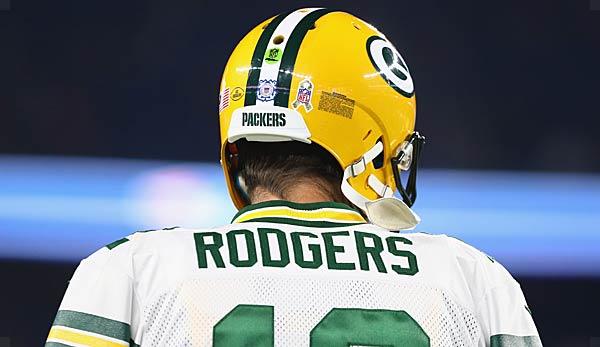US-Sport
NFL: Column: Lamar Jackson – and the Packers Offense in the Crisis
Week 11 in the NFL, and the problems of the Green Bay Packers can no longer be discussed away. What should the consequences be? How did Lamar Jackson’s debut with the Baltimore Ravens go? What clear signals do the Jaguars send, who wins the NFC East – and a first look at the draft.
You want to ask questions to the SPOX-NFL column? This goes right here to the author!
A few short thoughts about the incredible game on Monday evening in Los Angeles: This game was the perfect visualization of football in the NFL in 2018. In the past weeks, I had made the point several times that there is no dominant defense this year; what I mean is a defense that can dominate a game constantly and especially against good offenses. The top offenses in the league will move the ball and score points, no matter against whom it goes.
The Super Bowl with its 1,151 combined yards and 14 scoring drives was the perfect example: the offenses dominated the game as far as possible completely, but in the end it was the one big play of the Eagles Defense – a forced fumble 2:16 minutes before the end – that decided this game.
At least for the time being, one has to say goodbye to the idea that defenses can control a game of this magnitude, as it was in the past – the Seahawks at their peak are certainly the best example of this, the Broncos and Jaguars in recent years also fall into this category – the case.
But there is still a place for Defenses in today’s NFL, and the duel on Monday evening also showed that. Eight sacks, three defensive scores and seven turnovers in total show how the task for a defense has changed: since the really good offenses don’t rely so much on ball possession and long drives – the Rams had less yards against KC at their 54 points than the Buccaneers the week before against Washington (3 points) – it’s not the job of a defense to control the offense.
It’s about defensively countering the big play offenses with one or two big plays. That will make the difference, even in the playoffs; no controlling defense. The elite openings in the NFL are currently too strong and too far ahead for this.
Due to injury, the Ravens were forced to swap quarterbacks in the end, the scenario could repeat itself in the coming week – and then? What would Baltimore do when Joe Flacco’s fit again? Does Flacco currently give ravens a better chance of winning? Or Jackson? With which quarterback can they cause opponents bigger problems, still look towards playoffs – and secure John Harbaugh’s wobbly chair again?
One thing is clear, and this became clear on Jackson’s starting debut against the Bengals: with the rookie quarterback, the Ravens-Offense looks dramatically different than it did with Flacco.
Jackson had 27 runs against Cincinnati – no quarterback in the Super Bowl era ever had (!) so many rushing attempts in one game. It was the highest value since Pittsburgh’s Joe Geri ran 29 times in 1950.
Jackson has almost doubled the Ravens franchise record for a quarterback’s Rushing Yards (so far: Tyrod Taylor, 65 Rushing-Yards 2012) and his 64 Rushing-Yards in the first half were the second highest for a rookie quarterback in a first half since 1991; only Russell Wilson in week 15 of the 2012 season had more (72).
And it was completely planned that way: only three of his 27 runs were scrambles, the remaining 24 runs were designed runs, one of which can be seen here as an example.
The Ravens, on their first drive, which ran over eleven plays and without a passport, come out at an early third down in their own half in empty formations. The Bengals react conservatively, with a 2-man coverage: a 4-men rush, two deep safetys in zone coverage, otherwise everywhere one-on-one coverage.
It’s an invitation to the Ravens’ play call. They play a designed quarterback draw, so this is not a scramble; the center that blocks downfield directly provides the indicator. And the route combinations on both sides clear the way to allow Jackson a long run behind the center as lead blocker. With the Bengal play call, there is no defender in the box to respond to Jackson.
Baltimore’s general approach was simply different: the Ravens ran in 74 percent of their offensive snaps and threw the ball in just 26 percent; the league average this season is around 60 percent passes. Baltimore themselves have had a pass rate of over 60 per cent this season.
The Ravens had several packages ready for Jackson, after all they had played the occasional trick plays with their rookie quarterback throughout the season. With (faked) Jet Sweeps, Zone Reads, Option Plays, formations with several players in the backfield, formations with the tackles Outside posted – the Ravens-Offense with Jackson instead of Flacco gave Cincinnatis Defense some thinking tasks.
Nevertheless, one central aspect remains: in today’s NFL, you have to be able to throw the ball. And the approaches Baltimore showed here should make Ravens fans optimistic.
Especially in the last season it was a central problem of the Ravens-Offense that they were too one-dimensional and too predictable, because the Run Plays and the Passing Plays didn’t build up enough on each other. That’s why Baltimore invested in Tight Ends to get back to the 2-TE sets and run out of them and into the Play Action Game.
In fact, Baltimore plays league-wide with the most 2-TE formations after the Eagles, Texans and Titans – and throws from them frequently and successfully: almost 60 percent of their plays from 2-TE sets are passes – for 8.4 yards per pass.
This also helps Jackson, and with him on the field the factor of combining run and pass plays is even more dangerous for the defense.
You can see it with this route combination and this play call. A short completion at the end, but the design and the formation are the interesting part. The Ravens had against Cincinnati several plays with exactly this or very similar formation: A running back behind Jackson, a tight end or fullback slightly offset in front of Jackson.
From there they ran regularly, they ran Zone Reads – and here they use exactly such a formation for the passport. The Bengals focus on the center because they expect a run. Jackson finds his tight end after the play action fake, which runs from the backfield into the flat and waits there uncovered for the pass.
This play action pass falls into a similar category 9:20 minutes before the half-time break. Baltimore again presents a typical Run-Personnel and a close formation, at 1st&10 the Bengals are looking for a pass.
After the snap the line blocks to the right, a pull blocker comes over to the left side and protects the backside of the play together with the running back and fullback positioned in the backfield.
Jackson can move to his right side after the play action fake unhindered via rollout. On the side, both tight ends have gone into their route, and there is a crossing route through the receiver on the other side. Jackson thus has several options for a comparatively secure pass and gets a simple read.
With these funds, Baltimore’s offense in the passing game over the next few weeks can become even more dangerous and, above all, more difficult to calculate.
What’s the bottom line? Baltimore’s approach makes the Ravens a new challenge for Defenses in any case.
Flacco, after a good start to the season, had recently lost much of its momentum, especially the explosive element in the offense – the Baltimore so clearly missed last year and seemed to be back over the first quarter of the season – has now been largely lost again. About Flacco’s last five games (Steelers, Panthers, Saints, Titans, Browns), his record for pass attempts over at least 20 yards is: 4/30, 94 YDS, 2 INT.
At the same time, Baltimore have not been able to run the ball so well over the last few weeks, and this is of course connected. Defenses can play the box more aggressively again, because the vertical passing game doesn’t look so dangerous anymore. Under the premise that Flacco can’t suddenly switch on the Big Plays again in the passing game, the Ravens have to ask themselves: how do we get Big Plays together offensively?
In Passing Game you shouldn’t (yet) expect them from Jackson, at least constantly. But with the Rookie, the Ravens are able to create explosive plays at least via the Run Game. Against Cincinnati Baltimore had eight runs over at least ten yards, 15 runs for a new first down and especially over the middle various explosive plays. It was only for the fourth time this season that Baltimore’s Offense broke the 400-yard barrier.
And it is also clear: Jackson will have to deliver more against stronger opponents in the passing game than he did against an inconstant Bengals-Offense and a Bengals-defense that has been susceptible for weeks. At the same time, Baltimores Offense presents an unusual challenge for NFL-Defenses in this form, if the Ravens can extend the Zone Read style and develop the Passing Game based on it (e.g. with Run Pass Options, Play Actions, Passing Designs based on the Runs), which is no small factor in the preparation for the games.
Building on this, the question is: how big is the realistic chance that Flacco will regain its shape from the first quarter of the season and really make the difference as a passer? Or is it more likely that you will have the more unconventional, not necessarily contemporary, but still more dangerous offense with Jackson for this season’s outstanding games?
I’d bet on the latter.
Page 1: Lamar Jackson’s debut: Are the Ravens more dangerous with the rookie?
Page 2: The Offense and the Problems of the Packers – and Jacksonville’s Oath of Revelation
Page 3: NFC East Winner, Super Bowl Insider Tip, Top 5 Pick, Panthers – your questions


















You must be logged in to post a comment Login